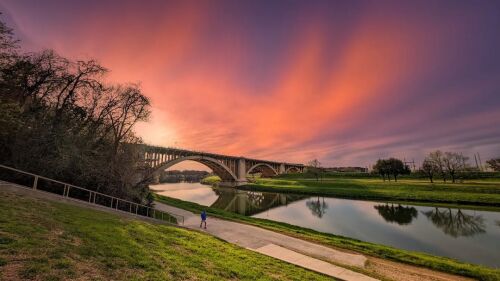Fort Worth was founded in 1849 and the city was incorporated in 1873 after growing out of a settlement and military outpost. Now that 150+ years have passed, the city and its streets are chock-full of vibrant history.
It’s safe to say that over the decades, the city has been touched by countless historical figures and happenings — many of which have shaped the names of Cowtown’s buildings, parks, and streets. In this guide, we’re delving into the history of Fort Worth’s streets — specifically how they were named.

Intersection of 6th and Throckmorton Streets in 1945.
Photo courtesy of UTA Libraries
Downtown
The city’s central business district is most known for the 37 square blocks known as Sundance Square. Downtown’s high rises are interspersed with public areas like Burnett Park and the Water Gardens, as well as Sundance Square Plaza, which hosts community events year-round. Many of the downtown street names reference Texas veterans and early government officials and share names with other Texas counties.
Throckmorton Street — named after James Webb Throckmorton, a veteran of the Mexican War who later worked as a physician, lawyer, and politician. He served as the 12th governor of Texas from 1866-1867.
Henderson Street — named after James Pickney Henderson, the first governor of Texas in 1846. Henderson County located southeast of Dallas also bears his name.
Lancaster Street — renamed for John Lynch Lancaster, the president of the Texas and Pacific Railroad in 1931. It was originally known as Front Street in the 1880s. Learn more about the major transportation hub.
Lamar Street — named after Mirabeau Bounaparte Lamar, president of the Republic of Texas starting in 1838. Streets in Dallas, Austin, Houston, and San Antonio also bear his name.

Aerial view of Camp Bowie Boulevard in 1956.
Photo courtesy of UTA Libraries
Cultural District
Located on the west side of downtown, the Cultural District is home to Cowtown’s museums and sporting arenas. Between the world-renowned Kimbell Art Museum and the Will Rogers Memorial Center, the area’s street names recognize performers and reference the neighborhood’s history as a military outpost.
Van Cliburn Way — named after pianist Harvey Lavan “Van” Cliburn, Jr., who won the International Tchaikovsky Competition in 1958 and is the namesake of the quadrennial Cliburn International Piano Competition that started in 1962.
Will Rogers Road — named after William Penn Adair Rogers, an American vaudeville performer, who was famous for cowboy and Wild West entertainment in the 1920s and 1930s. The street provides access to the Will Rogers Memorial Center.
Camp Bowie Boulevard — named after Camp Bowie, a World War I military camp that was constructed in 1917 bearing the name of infamous frontiersman Jim Bowie.
Burnett Tandy Drive — named after Anne Valliant Burnett Tandy, a rancher, art collector, and philanthropist who owned the Four Sixes Ranch and was the first female member of the Fort Worth Chamber of Commerce.

Intersection of Vickery Boulevard and Hemphill Street in 1951.
Photo courtesy of UTA Libraries
Near Southside
The Near Southside was established as the city’s first streetcar suburb in the early 1900s. An extension of the central business district in downtown, the neighborhood fell into disrepair after World War II but has re-emerged as a popular spot for local businesses and bars.
Hemphill Street — named for John Hemphill, who served as a chief justice of the Texas Supreme Court from 1845-1858. At one time, the street was one of the most elegant avenues in town with a trolley car line.
Daggett Avenue — named after the Daggett brothers, Ephriam and Henry, who came to town in the 1850s and started the first hostelry. They were instrumental in the arrival of the railroad and helped bring fresh drinking water to the growing community.
Vickery Boulevard — named for Richard L. Vickery, a confectioner who lived in Waxahachie in the 1880s before becoming a real estate broker and property developer in Cowtown.
Jennings Avenue — named after Thomas Jefferson Jennings, a legislator who served as the Texas attorney general from 1852-1856. He moved to Fort Worth in 1877 where he lived for the remainder of his life.

Aerial view of Foch Street and West 7th Street in 1949.
Photo courtesy of UTA Libraries
Foundry District
Located north of the West 7th entertainment corridor, the Foundry District features mid-century industrial buildings — many of which have been revamped by local beverage companies. Inspiration Alley, a series of colorful murals by local artists, is a gem of the neighborhood.
White Settlement Road — named for unsurprisingly white settlers who built homesteads in the 1850s. In 2019, city representatives considered changing the name of the street and the surrounding neighborhood to respect the Indigenous peoples who lived in the area before the settlement — but the initiative was scrapped in January of 2023.
Bailey Avenue — named for William John Bailey, who was once one of the largest landowners in town. Bailey came to Cowtown in 1882 and founded the Greenwood Memorial Park in 1901, which features replicas of the Venetian Four Horses statues.
Foch Street — (pronounced foʊsh) renamed for World War I French military commander Ferdinand Foch in 1922. Previously, it was known as Franklin Street.












